Comprehensive Scale Fusion Networks with High Spatiotemporal Feature Correlation for Air Quality Prediction
Abstract
1. Introduction
2. Related Materials and Concepts
2.1. Spatiotemporal Encoder
2.2. Preliminaries
- (1)
- Air quality flow graph (AQFG): the air quality flow graph is defined as , and the citywide air quality data for the pre-T moment are expressed by a tensor , .
- (2)
- Spatial region: each monitoring station Mt is represented as a graph node with a feature vector , encapsulating multivariate air quality measurements (e.g., PM2.5, SO2, and O3) and meteorological conditions (wind speed and temperature) at the station.
2.3. Time Series Imaging
2.4. Evaluation Indexes
3. Propose Models and Methodologies
3.1. Overview of the Proposed CSST-AQP Framework
3.2. Localized Spatiotemporal Feature Preprocessing Module (LSTF-Net)
3.3. The Structure of Complete Scale Spatial Processing Network (CSSP-Net)
3.4. Adaptive Temporal Feature Enhancement Network (ATSE-Net)
| Algorithm 1: APO-SO optimization for TSE module | ||
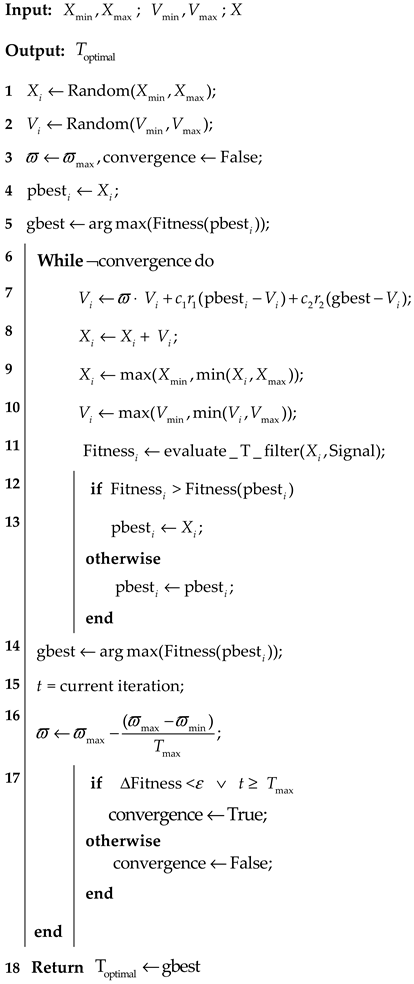 | ||
4. Experimental Section and Results
4.1. Training Details and Datasets
4.2. Feature Visualization
4.3. Analysis of Projected Results
4.4. Comparative Experiment
4.4.1. Compared with Deep Learning Models
Compared with Traditional Models
4.5. Ablation Experiments
4.5.1. Module Ablation
- 1.
- LSTF-Net Removal:
- 2.
- CSSP-Net Ablation
- 3.
- ATSE-Net Exclusion
4.5.2. Hyperparameter Analysis
4.6. Parameter Sensitivity and Robustness
4.6.1. Different Data Sources
4.6.2. Parameter Sensitivity
4.6.3. Noise Sensitivity
5. Discussion
6. Conclusions
Author Contributions
Funding
Institutional Review Board Statement
Informed Consent Statement
Data Availability Statement
Conflicts of Interest
References
- Chen, X.H.; Tee, K.; Elnahass, M.; Ahmed, R. Assessing the environmental impacts of renewable energy sources a case study on air pollution and carbon emissions in China. J. Environ. Econ. Manag. 2023, 345, 118525. [Google Scholar]
- Pan, K.; Lu, J.; Li, J.; Xu, Z. A hybrid autoformer network for air pollution forecasting based on external factor optimization. Atmosphere 2023, 14, 869. [Google Scholar] [CrossRef]
- Zheng, Y.; Liu, F.R.; Hsieh, H.P. U-Air: When urban air quality inference meets big data. In Proceedings of the 19th ACM SIGKDD International Conference on Knowledge Discovery and Data Mining, Chicago, IL, USA, 11–14 August 2013; pp. 1436–1444. [Google Scholar]
- Gu, K.; Qiao, J.; Lin, W. Recurrent air quality predictor based on meteorology- and pollution-related factors. IEEE Trans. Ind. Inform. 2018, 14, 3946–3955. [Google Scholar]
- Steinfeld, J.I. Atmospheric chemistry and physics from air pollution to climate change. Environ. Sci. Policy 1998, 40, 26. [Google Scholar]
- Flatøy, F.; Hov, O.; Schlager, H. Chemical forecasts used for measurement flight planning during POLINAT 2. Geophys. Res. Lett. 2000, 27, 951–954. [Google Scholar]
- Osipov, A.V.; Pleshakova, E.S.; Gataullin, S.T. Production processes optimization through machine learning methods based on geophysical monitoring data. Comput. Optim. 2024, 48, 633–642. [Google Scholar]
- Rizos, K.; Meleti, C.; Evagleopoulos, V.; Melas, D. A machine learning modelling approach to characterize the background pollution in the Western Macedonia region in northwest Greece. Atmos. Pollut. Res. 2023, 14, 101877. [Google Scholar]
- Mendez, M.; Merayo, M.G.; Nuez, M. Machine learning algorithms to forecast air quality a survey. Artif. Intell. Rev. 2023, 56, 10031–10066. [Google Scholar]
- Liu, H.; Yan, G.X.; Duan, Z.; Chen, C. Intelligent modeling strategies for forecasting air quality time series: A review. Appl. Soft Comput. 2021, 102, 106957. [Google Scholar]
- Zhang, Y.P.; Chen, D.; Luo, Y. Low-SOC estimation of aluminum-air battery based on HSMM. J. Univ. Electron. Sci. Technol. China 2017, 46, 380–385. [Google Scholar]
- Mampitiya, L.; Rathnayake, N.; Leon, L.P.; Mandala, V.; Azamathulla, H.M.; Shelton, S.; Hoshino, Y.; Rathnayake, U. Machine learning techniques to predict the air quality using meteorological data in two urban areas in Sri Lanka. Environments 2023, 10, 141. [Google Scholar] [CrossRef]
- Mampitiya, L.; Rathnayake, N.; Hoshino, Y.; Rathnayake, U. Forecasting PM10 levels in Sri Lanka a comparative analysis of machine learning models PM10. J. Hazard. Mater. Adv. 2024, 13, 100395. [Google Scholar] [CrossRef]
- Athira, V.; Geetha, P.; Vinayakumar, R.; Soman, K.P. DeepAirNet applying recurrent networks for air quality prediction. Procedia Comput. Sci. 2018, 132, 1394–1403. [Google Scholar]
- Guo, Z.Y.; Yang, C.Y.; Wang, D.S.; Liu, H.B. A novel deep learning model integrating CNN and GRU to predict particulate matter concentrations. Process Saf. Environ. 2023, 173, 604–613. [Google Scholar] [CrossRef]
- Elbaz, K.; Shaban, W.M.; Zhou, A.N.; Shen, S.L. Real time image-based air quality forecasts using a 3D-CNN approach with an attention mechanism. Chemosphere 2023, 333, 138867. [Google Scholar] [CrossRef]
- Tran, H.D.; Huang, H.Y.; Yu, J.Y.; Wang, S.H. Forecasting hourly PM2.5 concentration with an optimized LSTM model. Atmos. Environ. 2023, 315, 120161. [Google Scholar] [CrossRef]
- Shi, X.; Chen, Z.; Wang, H.; Yeung, D.Y.; Wong, W.K.; Woo, W.C. Convolutional LSTM network: A machine learning approach for precipitation nowcasting. In Proceedings of the 29th International Conference on Neural Information Processing Systems, Montreal, QC, Canada, 7–12 December 2015; pp. 802–810. [Google Scholar]
- Zaini, N.; Ahmed, A.N.; Ean, L.W.; Chow, M.F.; Malek, M.A. Forecasting of fine particulate matter based on LSTM and optimization algorithm. J. Clean. Prod. 2023, 427, 139233. [Google Scholar] [CrossRef]
- Wang, C.; Huang, S.; Zhang, C. Short-term traffic flow prediction considering weather factors based on optimized deep learning neural networks: Bo-GRA-CNN-BiLSTM. Sustainability 2025, 17, 2576. [Google Scholar] [CrossRef]
- Ameri, R.; Hsu, C.C.; Band, S.S.; Zamani, M.; Shu, C.M.; Khorsandroo, S. Forecasting PM 2.5 concentration based on integrating of CEEMDAN decomposition method with SVM and LSTM. Ecotoxicol. Environ. Saf. 2023, 266, 115572. [Google Scholar] [CrossRef]
- Tishya, M.; Anitha, A. Hybridization of rough set-wrapper method with regularized combinational LSTM for seasonal air quality index prediction. Neural Comput. Appl. 2024, 36, 2921–2940. [Google Scholar]
- Wang, X.H.; Zhang, S.; Chen, Y.; He, L.Y.; Ren, Y.M.; Zhang, Z.; Li, J.; Zhang, S.Q. Air quality forecasting using a spatiotemporal hybrid deep learning model based on VMD–GAT–BiLSTM. Sci Rep. 2024, 14, 17841. [Google Scholar]
- Rabie, R.; Asghari, M.; Nosrati, H.; Niri, M.E.; Karimi, S. Spatially resolved air quality index prediction in megacities with a CNN-Bi-LSTM hybrid framework. Sustain. Cities Soc. 2024, 109, 105537. [Google Scholar]
- Fan, P.D.; Wang, D.; Wang, W.; Zhang, X.Y.; Sun, Y.Y. A novel multi-energy load forecasting method based on building flexibility feature recognition technology and multi-task learning model integrating LSTM. Energy 2024, 308, 132976. [Google Scholar]
- Huang, X.H.; Li, Y.F.; Wang, X.W. Integrating a multi-variable scenario with Attention-LSTM model to forecast long-term coastal beach erosion. Sci. Total Environ. 2024, 954, 176257. [Google Scholar]
- Wang, Y.; Liu, K.; He, Y.; Wang, P.; Chen, Y.; Xue, H.; Huang, C.; Li, L. Enhancing air quality forecasting a novel spatio-temporal model integrating graph convolution and multi-head attention mechanism. Atmosphere 2024, 15, 418. [Google Scholar] [CrossRef]
- Hu, W.; Zhang, Z.; Zhang, S.Q.; Chen, C.M.; Yuan, J.W.; Yao, J.; Zhao, S.C.; Guo, L. Learning spatiotemporal dependencies using adaptive hierarchical graph convolutional neural network for air quality prediction. J. Clean. Prod. 2024, 459, 142541. [Google Scholar]
- Chen, Y.S.; Huang, L.; Xie, X.D.; Liu, Z.X.; Hu, J.L. Improved prediction of hourly PM2.5 concentrations with a long short-term memory and spatiotemporal causal convolutional network deep learning model. Sci. Total Environ. 2024, 912, 168672. [Google Scholar]
- Hu, Y.X.; Li, Q.; Shi, X.D.; Yan, J.Y.; Chen, Y.T. Domain knowledge-enhanced multi-spatial multi-temporal PM2.5 forecasting with integrated monitoring and reanalysis data. Environ. Int. 2024, 192, 108997. [Google Scholar] [PubMed]
- Dey, S. Urban air quality index forecasting using multivariate convolutional neural network based customized stacked long short-term memory model. Process Saf. Environ. 2024, 191, 375–389. [Google Scholar]
- Zhu, J.M.; Zheng, P.; Niu, L.L.; Chen, H.Y.; Wu, P. An enhanced interval-valued PM2.5 concentration forecasting model with attention-based feature extraction and self-adaptive combination technology. Expert Syst. Appl. 2025, 264, 125867. [Google Scholar]
- Pande, C.B.; Kushwaha, N.L.; Alawi, O.A.; Sammen, S.S.; Sidek, L.M.; Yaseen, Z.M.; Pal, S.C.; Katipoglu, O.M. Daily scale air quality index forecasting using bidirectional recurrent neural networks: Case study of Delhi, India. Environ. Pollut. 2024, 351, 124040. [Google Scholar]
- Wang, K.N.; Yang, T.N.; Kong, S.S.; Li, M.D. Air quality index prediction through Time GAN data recovery and PSO-optimized VMD-deep learning framework. Appl. Soft Comput. 2025, 170, 112626. [Google Scholar]
- Mohammadzadeh, A.K.; Salah, H.; Jahanmahin, R.; Hussain, A.A.; Masoud, S.; Huang, Y.X. Spatiotemporal integration of GCN and E-LSTM networks for PM2.5 forecasting. Mach. Learn. Appl. 2024, 15, 100521. [Google Scholar]
- Ma, M.B.; Xie, P.; Teng, F.; Wang, B.; Ji, S.G.; Zhang, J.B.; Li, T.R. HiSTGNN: Hierarchical spatio-temporal graph neural network for weather forecasting. Inf. Sci. 2023, 648, 119580. [Google Scholar]
- Yang, W.H.; Li, H.M.; Wang, J.Z.; Ma, H.Y. Spatiotemporal feature interpretable model for air quality forecasting. Ecol. Indic. 2024, 167, 112609. [Google Scholar]
- Che, J.X.; Hu, K.; Xia, W.X.; Xu, Y.F.; Li, Y.R. Short-term air quality prediction using point and interval deep learning systems coupled with multi-factor decomposition and data-driven tree compression. Appl. Soft Comput. 2024, 166, 112191. [Google Scholar]
- Zhang, M.L.; Sun, L.F.; Yang, J.; Zou, Y.S. A shared multi-scale lightweight convolution generative network for few-shot multivariate time series forecasting. Appl. Soft. Comput. 2024, 167, 112420. [Google Scholar]
- Chen, Y.N.; Wu, Y.H.; Zhang, S.G.; Kee, Y.; Huang, J.; Shi, D.F.; Hu, S.X. Regional PM2.5 prediction based on hybrid directed graph neural network and spatio-temporal fusion of meteorological factors. Environ. Pollut. 2024, 366, 125404. [Google Scholar]
- Du, Z.; Wu, S.; Huang, D.; Li, W.; Wang, Y. Spatio-temporal encoder-decoder fully convolutional network for video-based dimensional emotion recognition. IEEE Trans. Affect. Comput. 2021, 12, 565–578. [Google Scholar]
- Wang, Z.G.; Oates, T. Imaging time-series to improve classification and imputation. arXiv 2015, arXiv:1506.00327v1. [Google Scholar]
- Deng, L.Y.; Liu, S.Y. Snow ablation optimizer a novel metaheuristic technique for numerical optimization and engineering design. Expert. Syst. Appl. 2023, 225, 120069. [Google Scholar]
- Air Quality Historical Data Platform. Available online: https://aqicn.org/data-platform/register/ (accessed on 10 September 2024).
- Sundaramoorthy, R.A.; Ananth, A.D.; Seerangan, K.; Nandagopal, M.; Balusamy, B.; Selvarajan, S. Implementing heuristic-based multiscale depth-wise separable adaptive temporal convolutional network for ambient air quality prediction using real time data. Sci. Rep. 2024, 14, 18437. [Google Scholar]
- Huang, Y.; Yu, J.; Dai, X.; Huang, Z.; Li, Y. Air-quality prediction based on the EMD–IPSO–LSTM combination model. Sustainability 2022, 14, 4889. [Google Scholar] [CrossRef]
- Neeraj; Mathew, J.; Behera, R.K. EMD-Att-LSTM a data-driven strategy combined with deep learning for short-term load forecasting. J. Mod. Power Syst. Clean Energy 2022, 10, 1229–1240. [Google Scholar]
- Wang, Z.C.; Chen, H.Y.; Zhu, J.M.; Ding, Z.N. Daily PM2.5 and PM10 forecasting using linear and nonlinear modeling framework based on robust local mean decomposition and moving window ensemble strategy. Appl. Soft Comput. 2022, 114, 108110. [Google Scholar]
- Li, Y.R.; Zhu, Z.F.; Kong, D.Q.; Han, H.; Zhao, Y. EA-LSTM evolutionary attention-based LSTM for time series prediction. Knowl. Based Syst. 2019, 181, 104785. [Google Scholar]
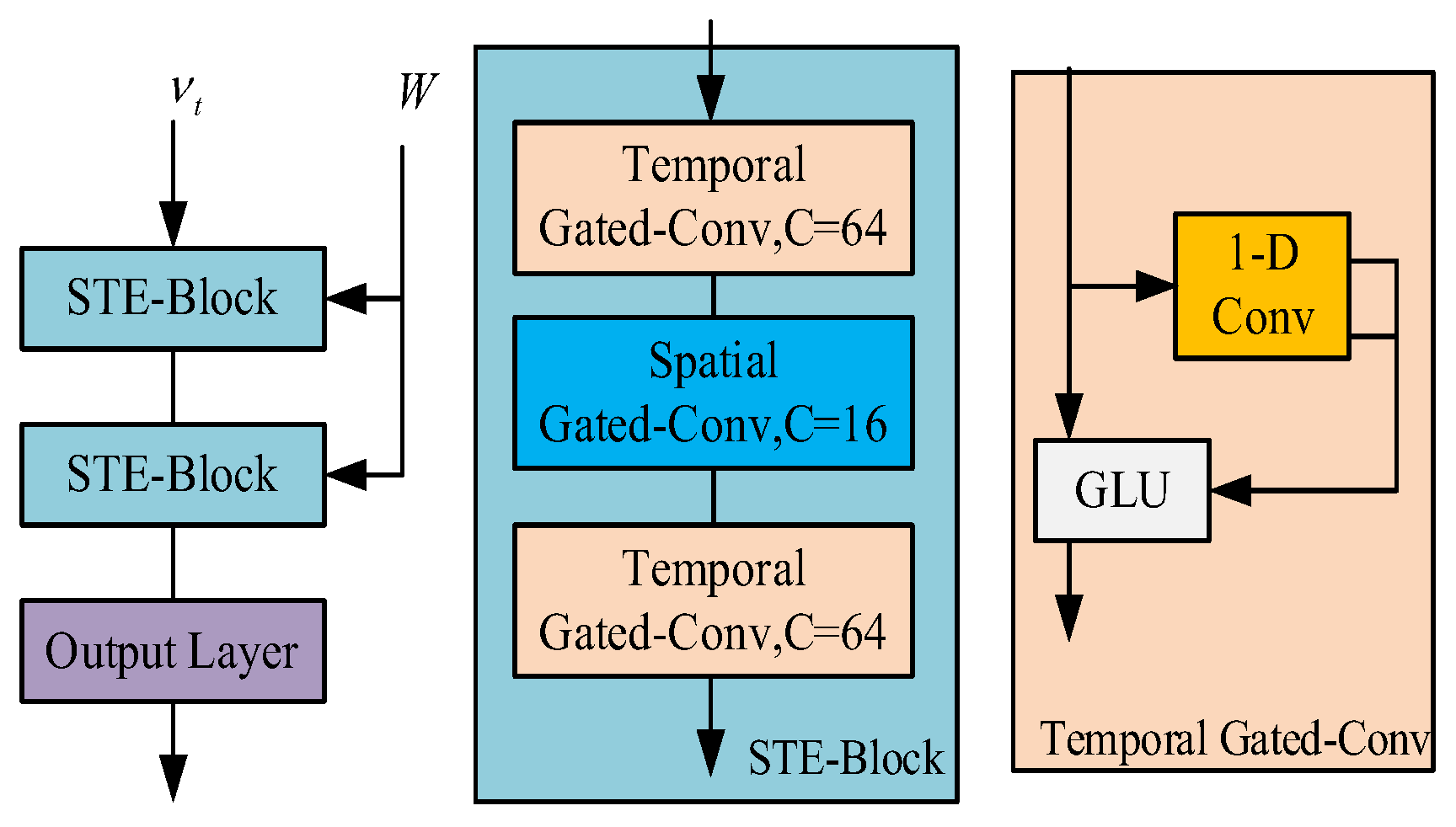
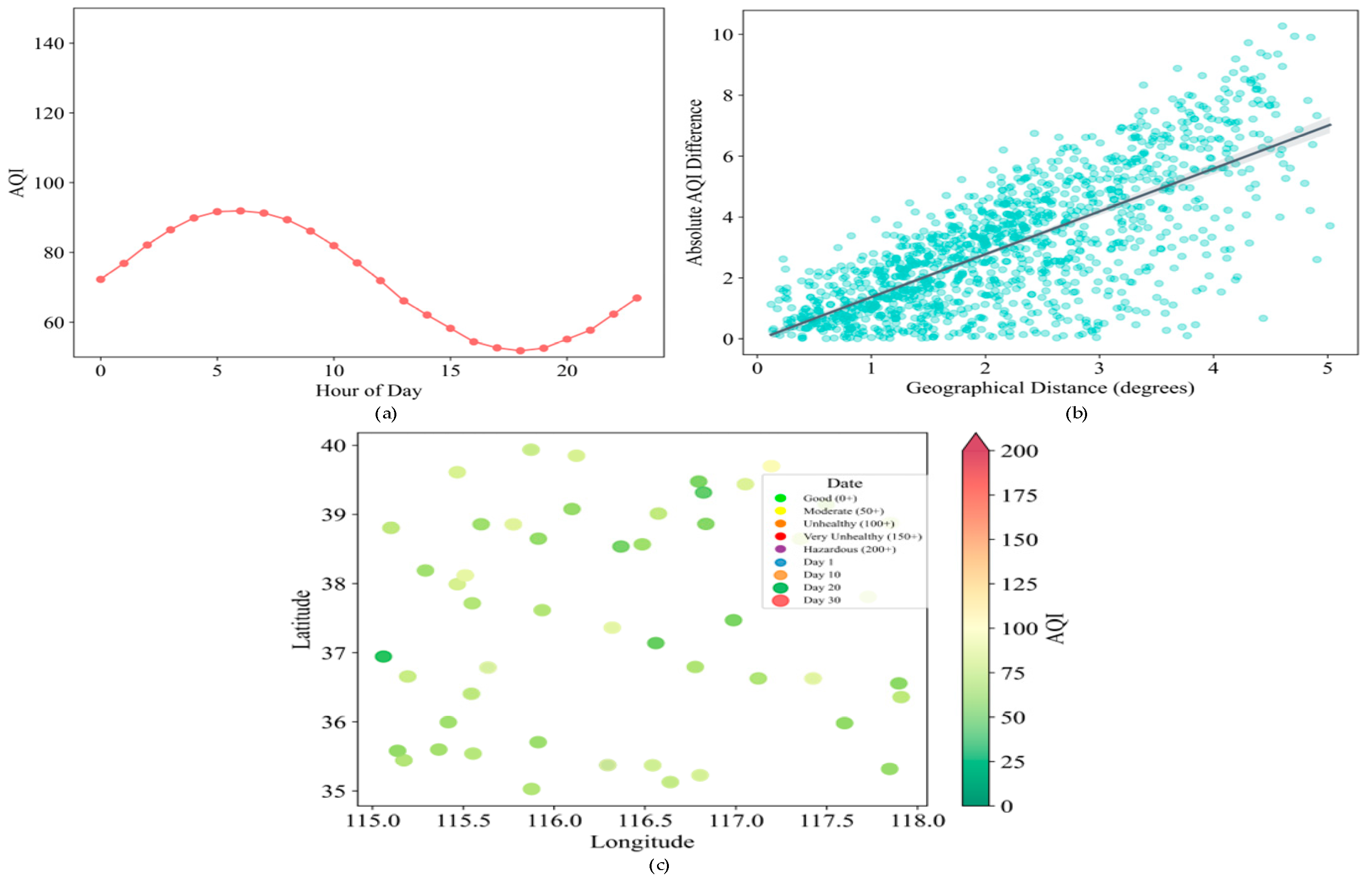
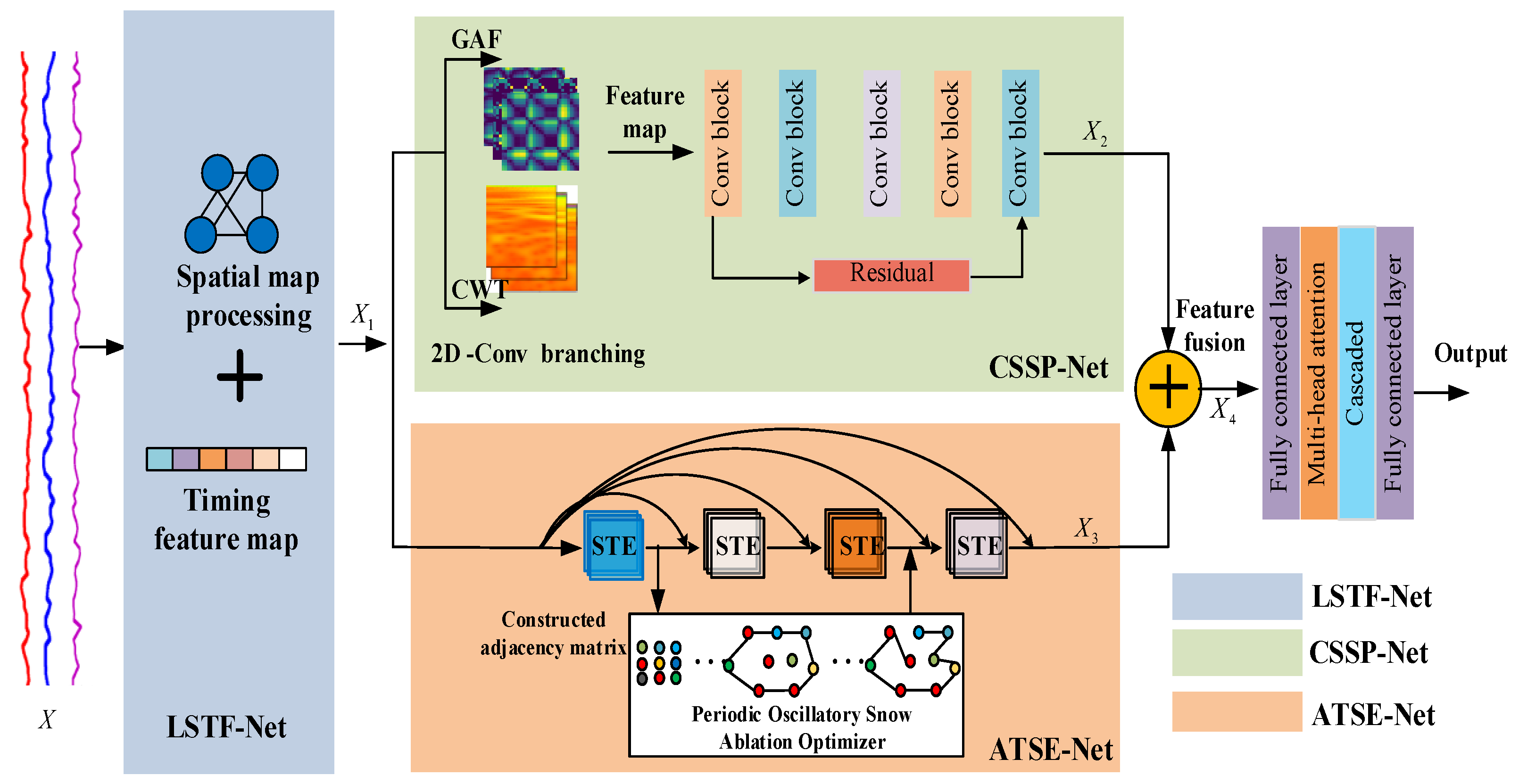
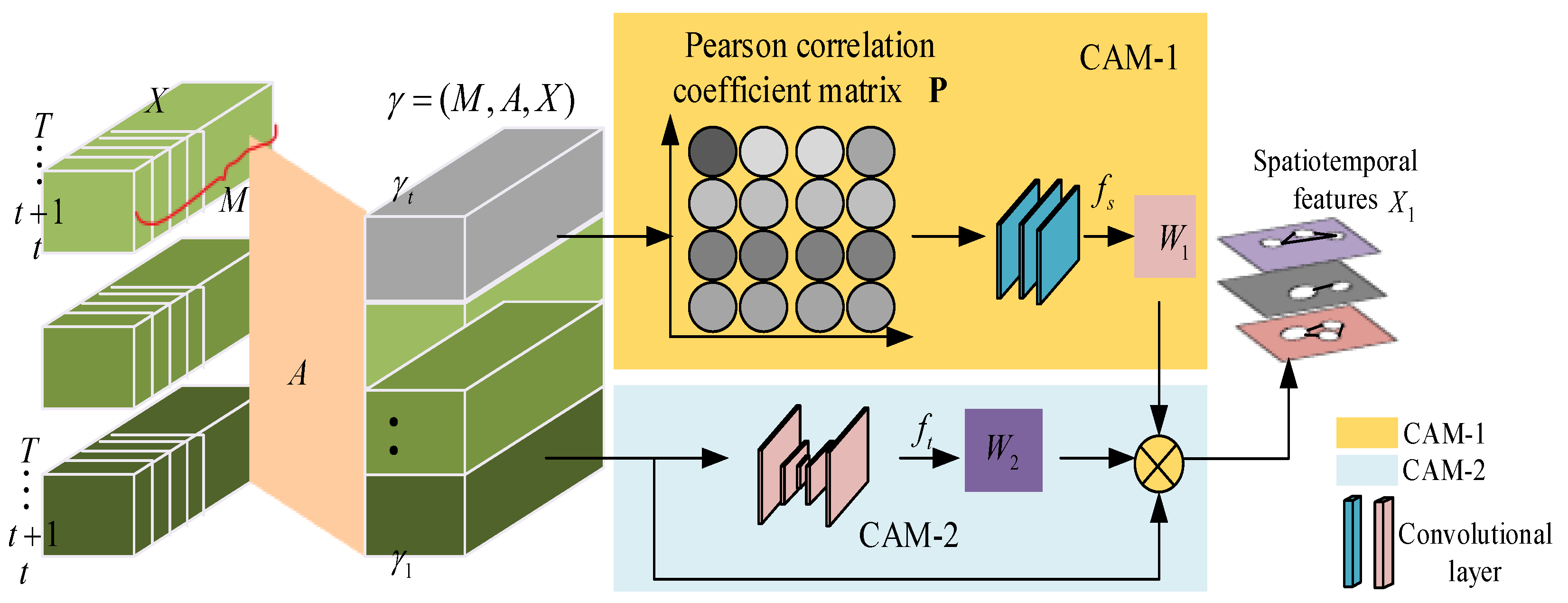
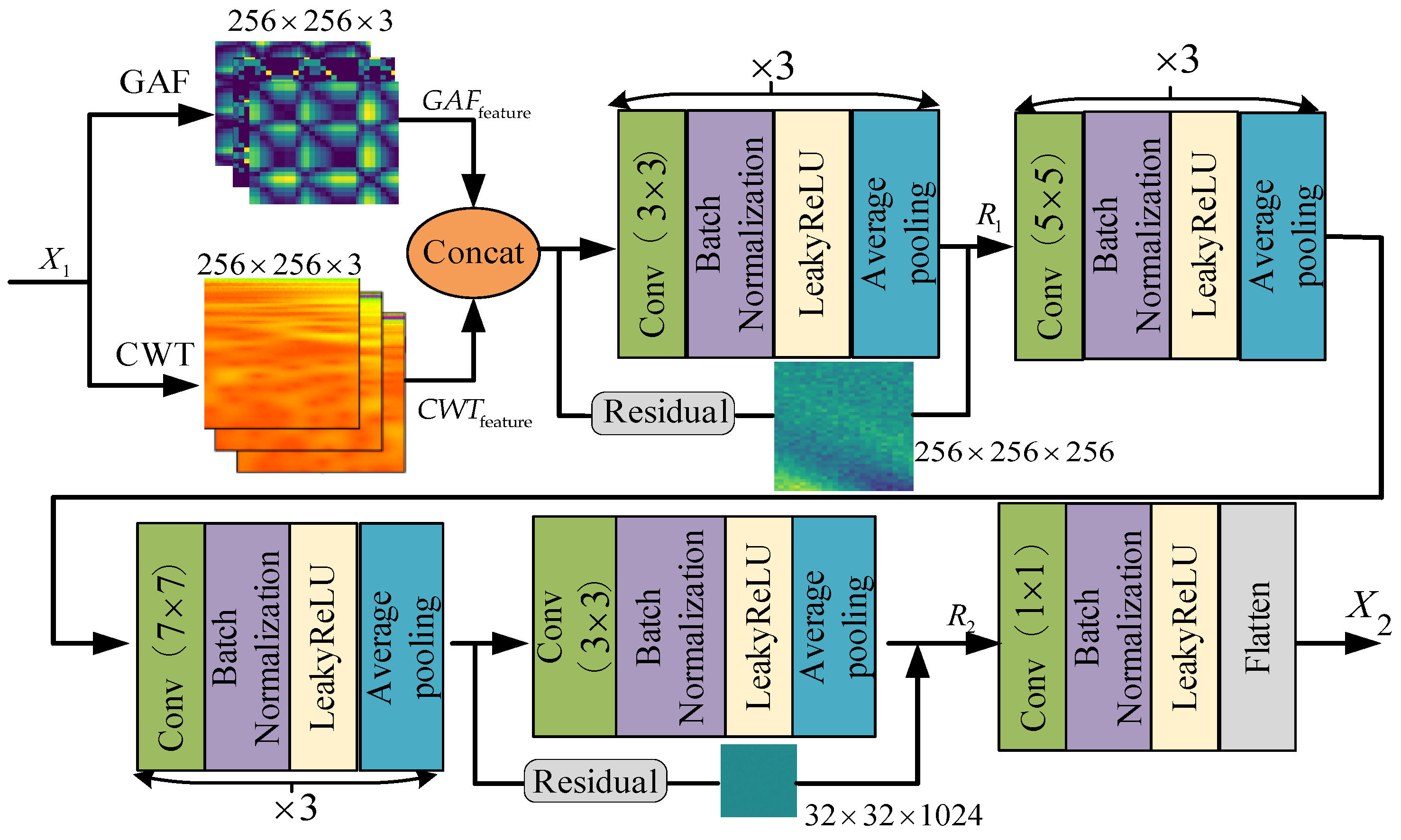

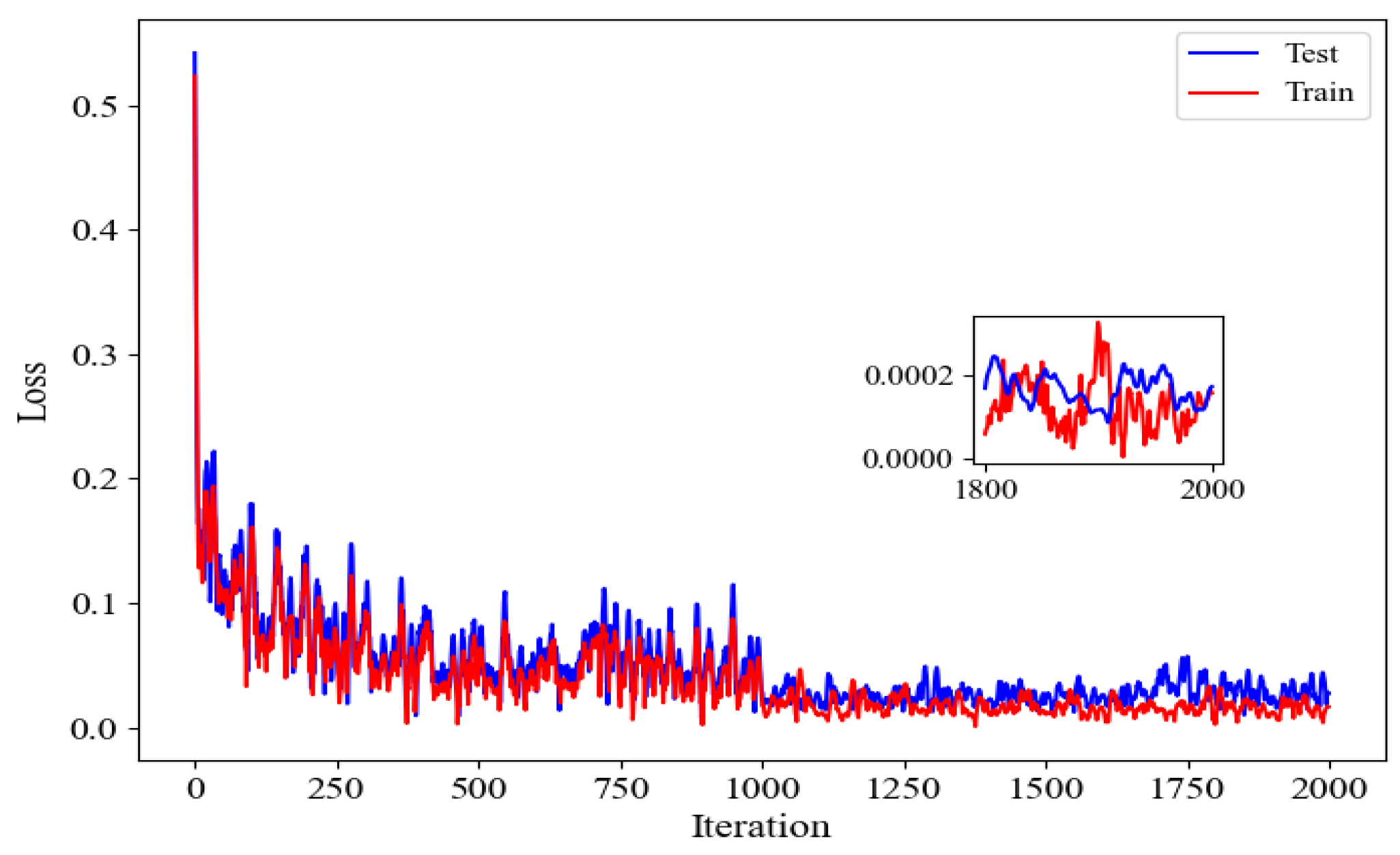
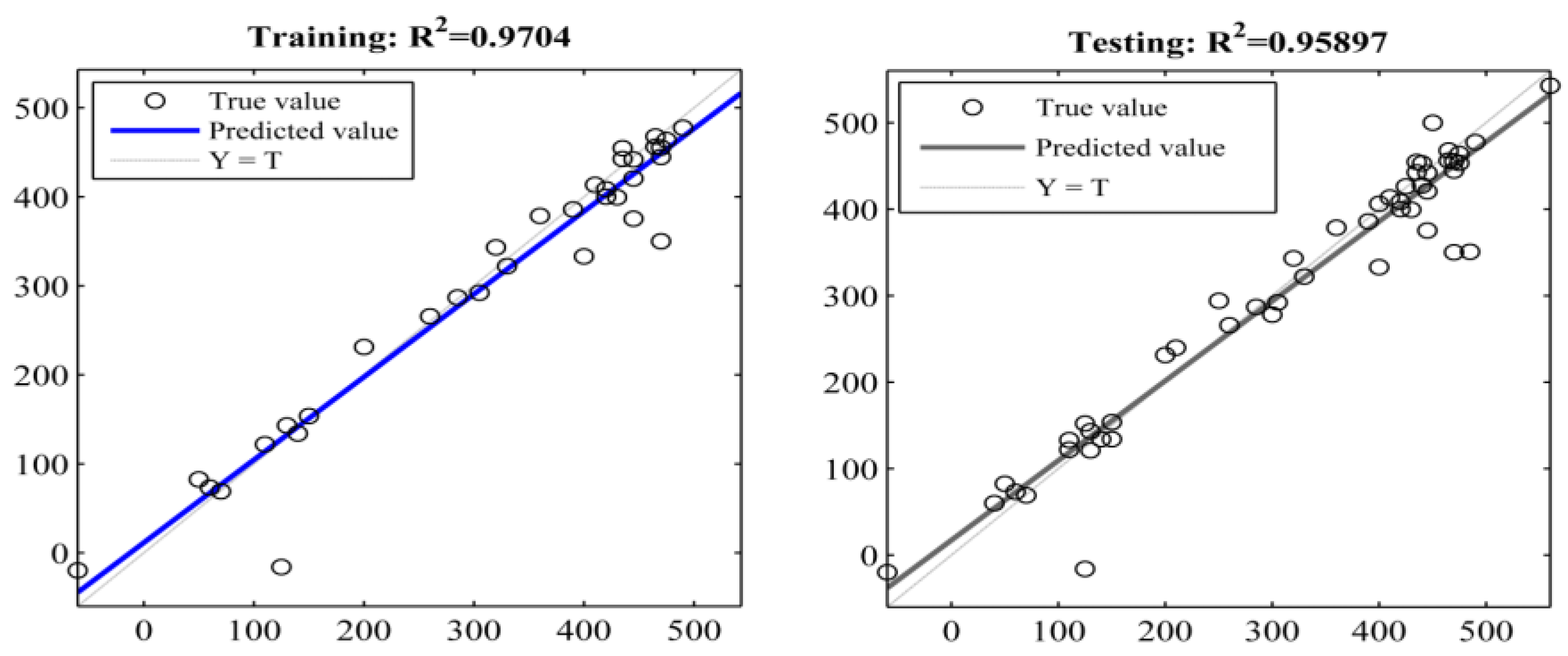


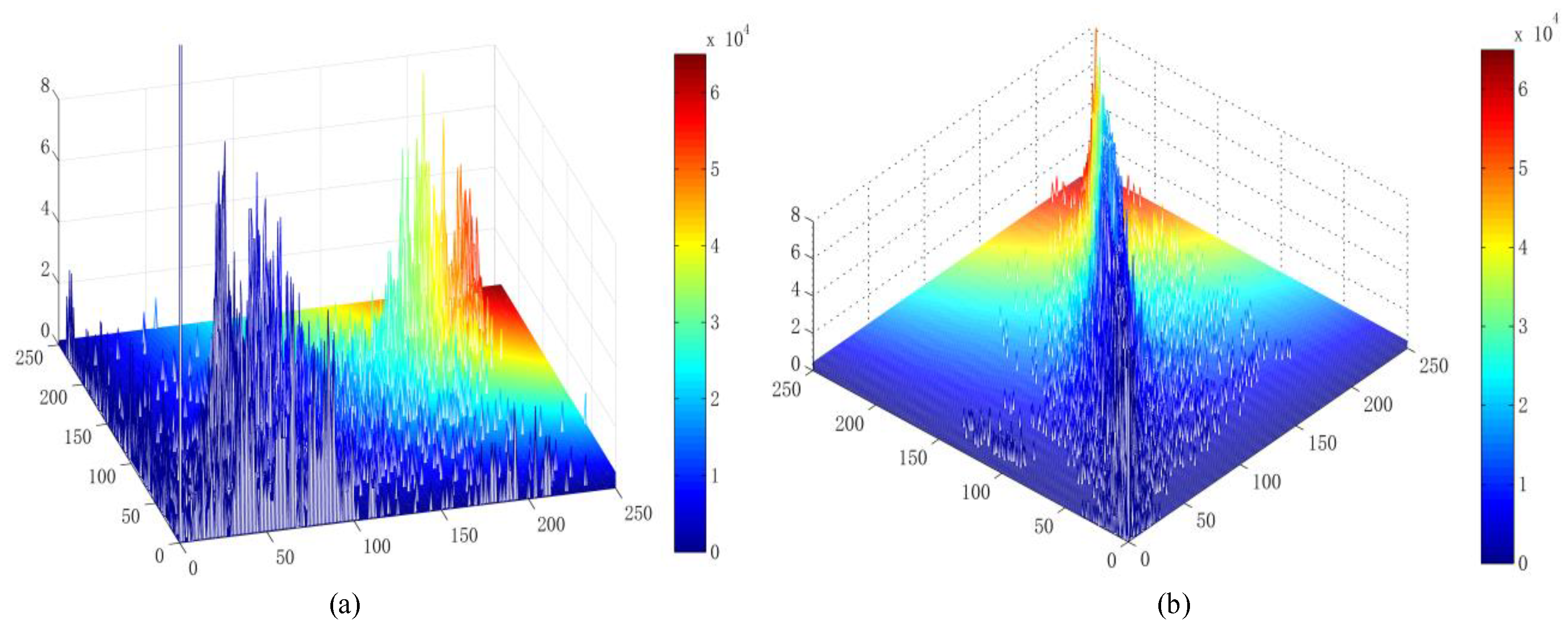
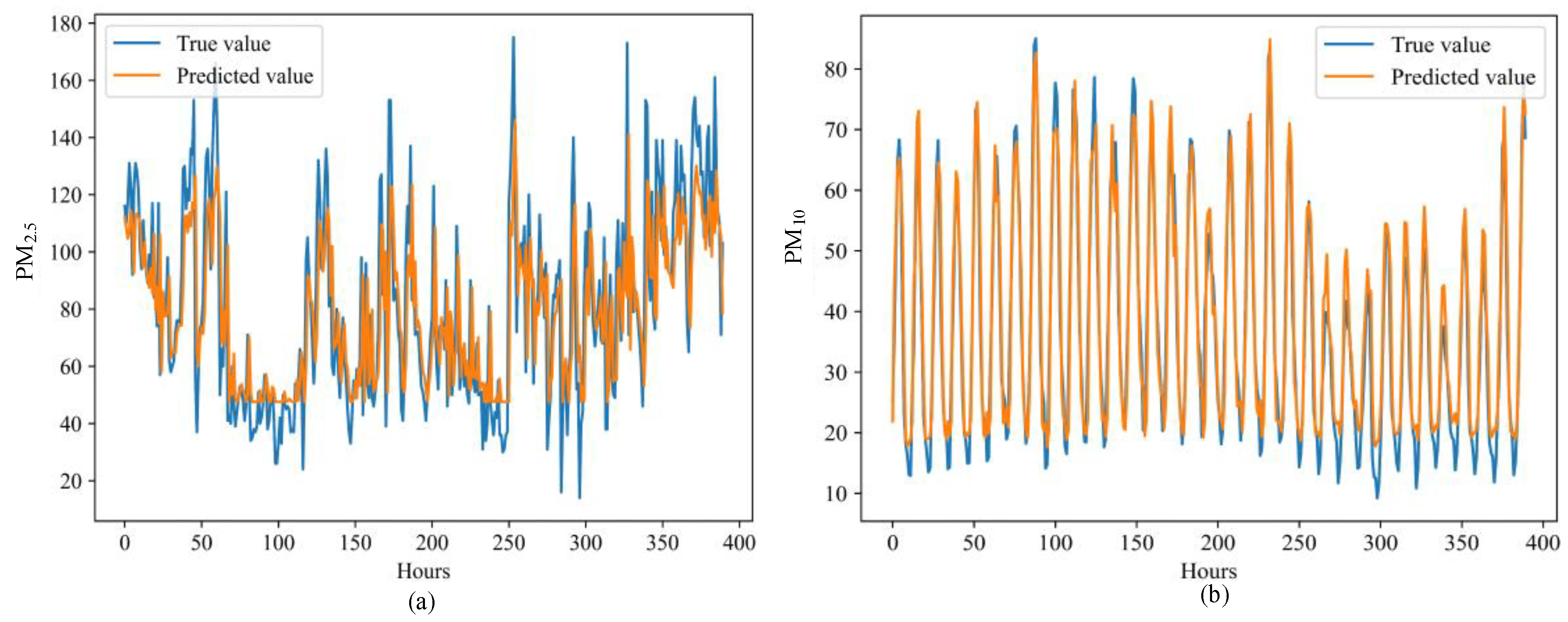
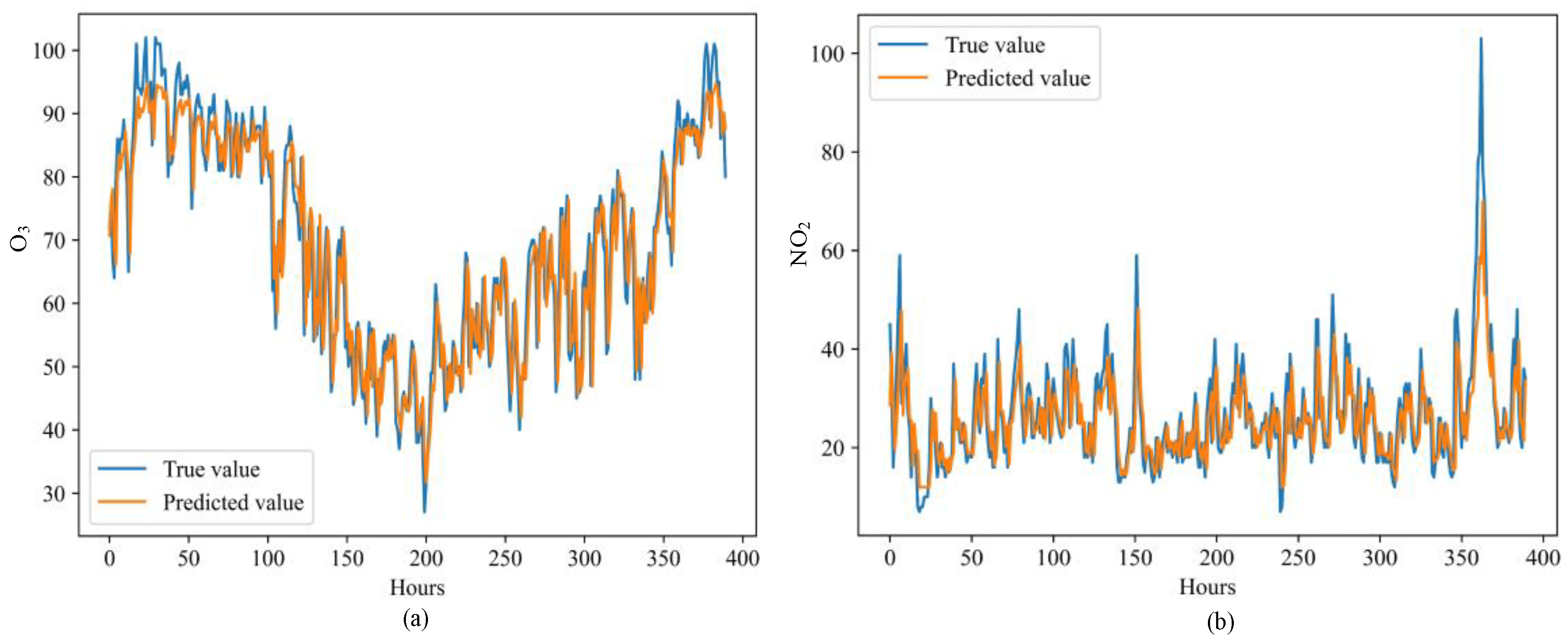

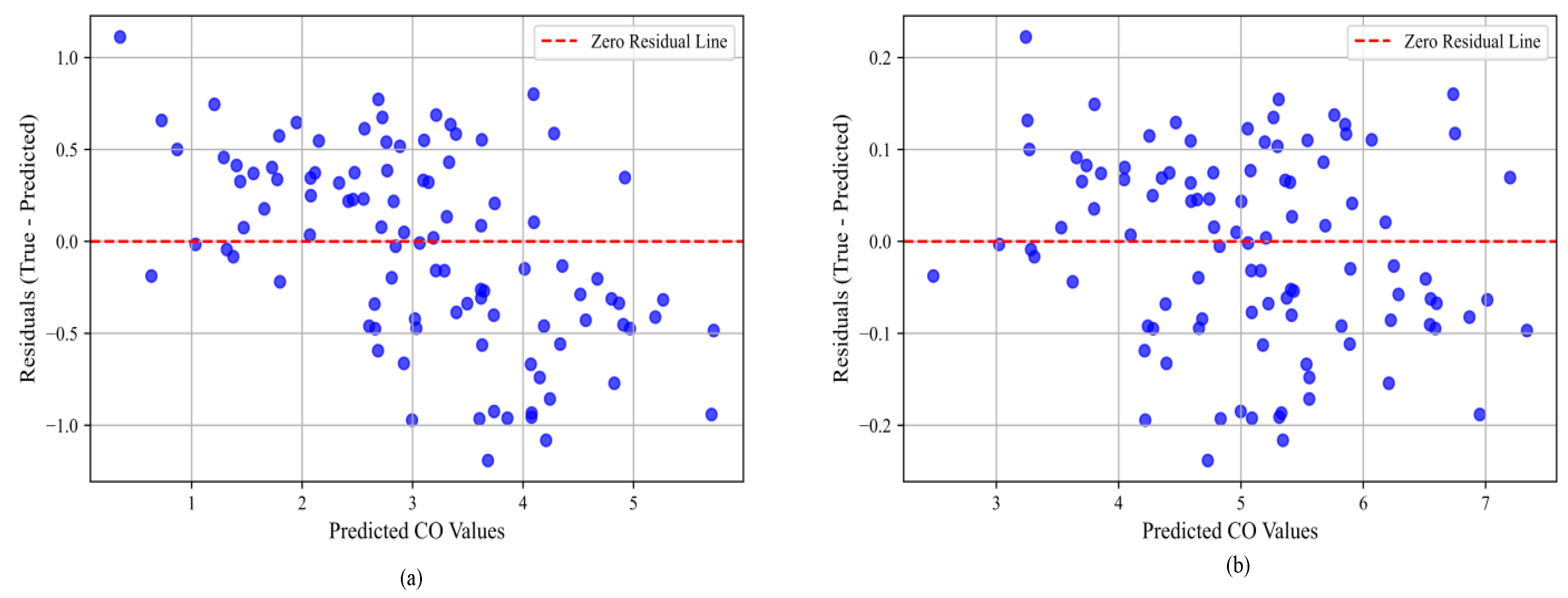
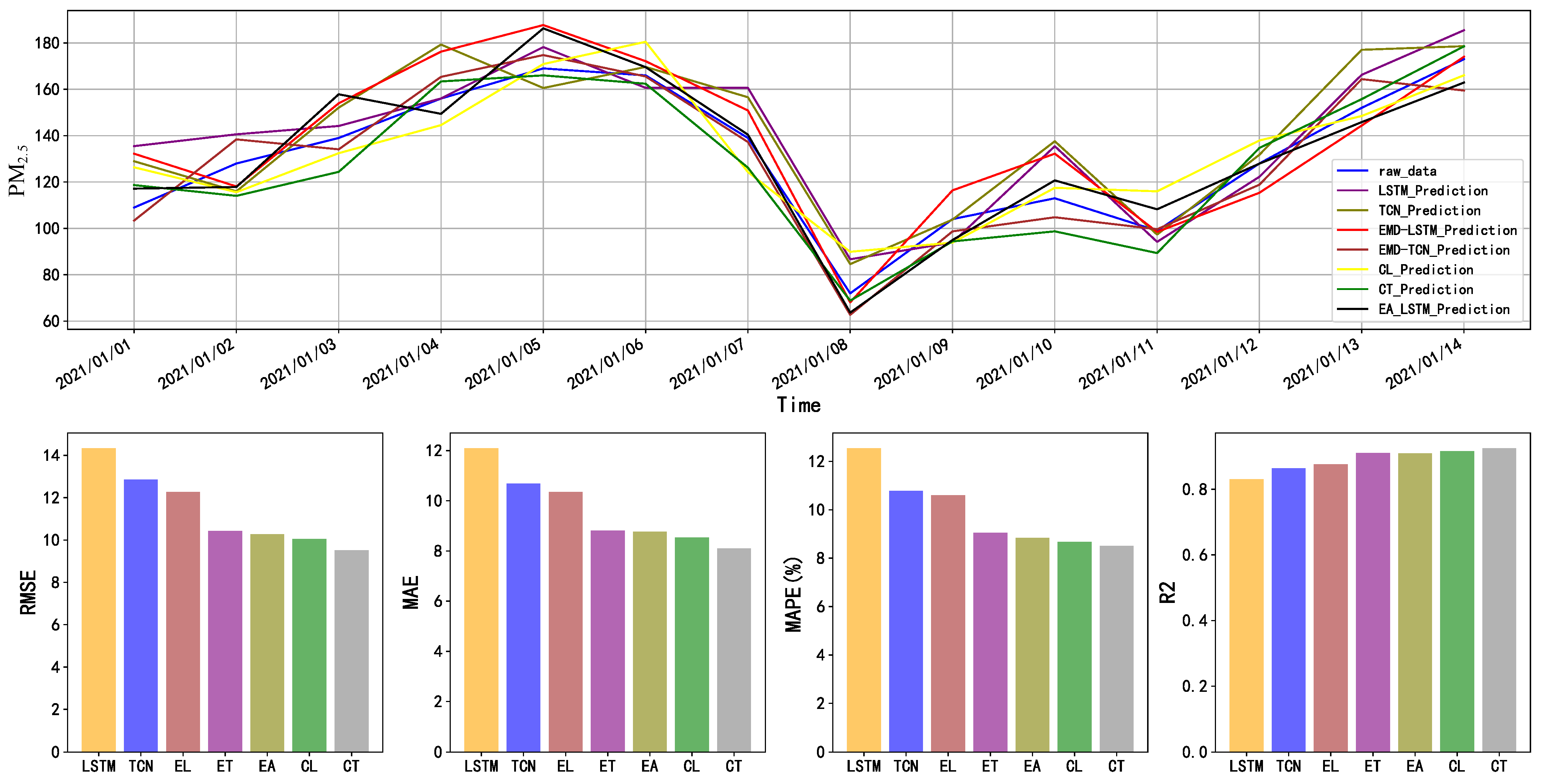
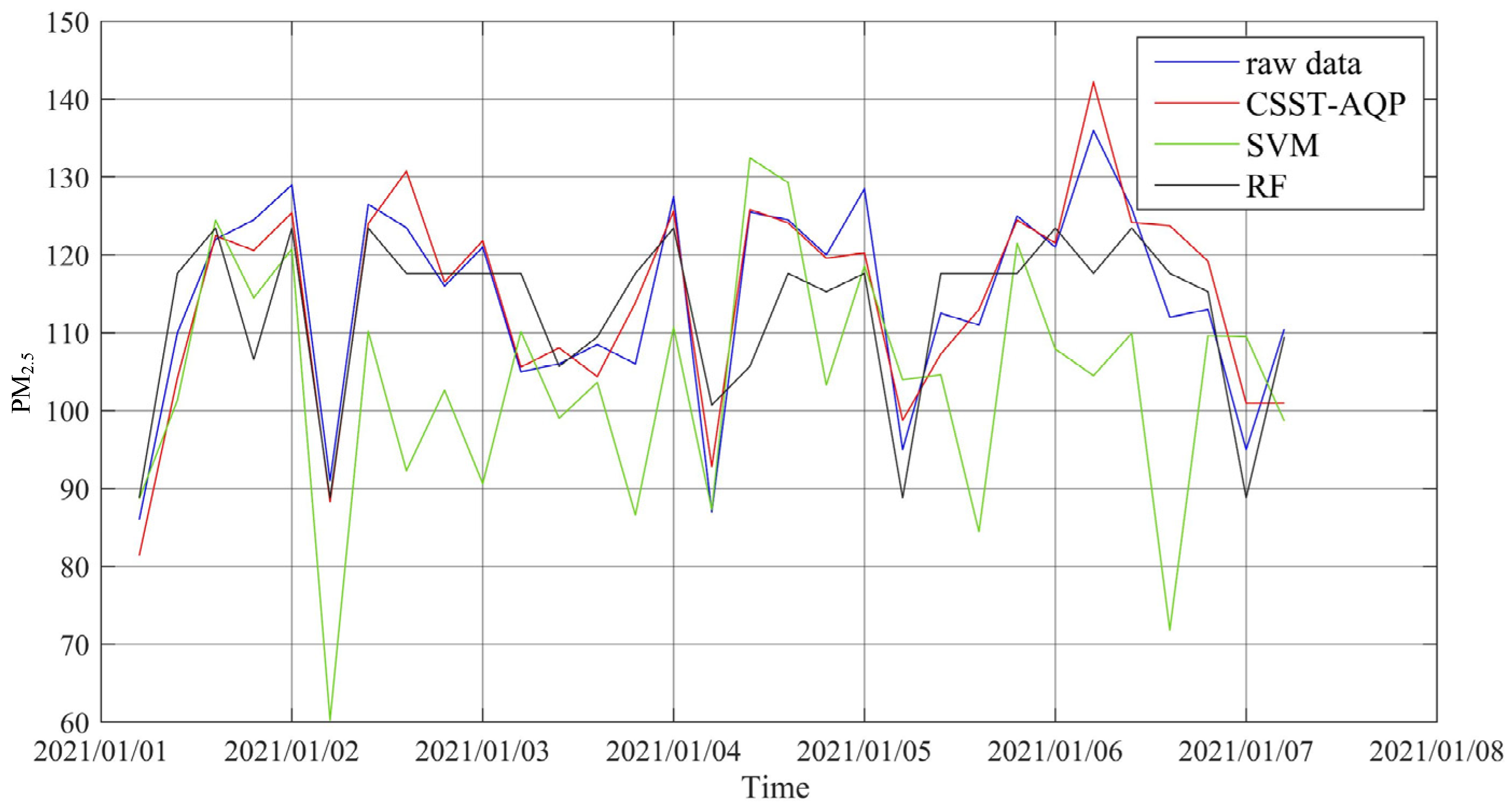
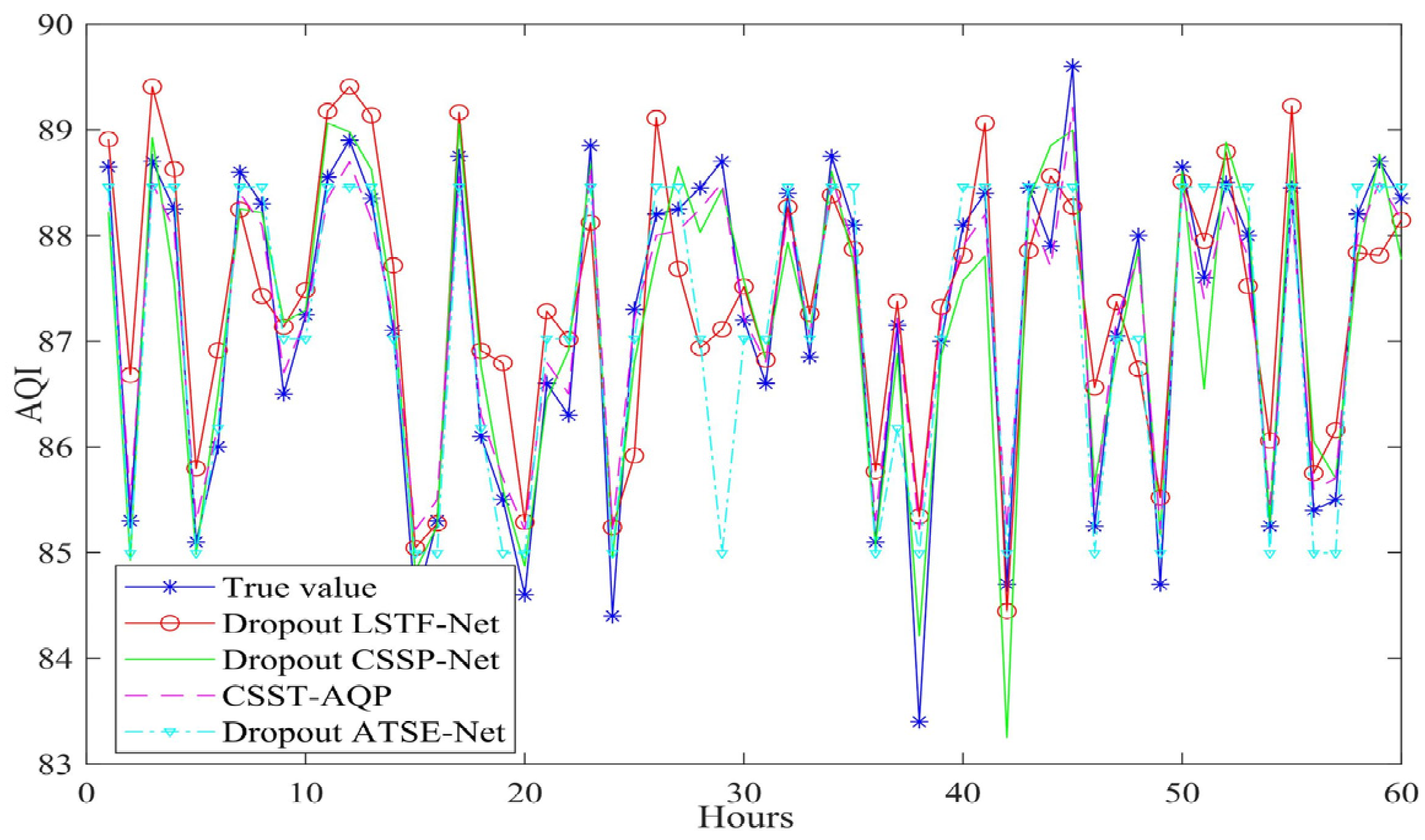



| Datasets | GZR | SGR |
|---|---|---|
| Number of air quality stations | 121 | 63 |
| Number of air quality records | 4,369,102 | 1,103,144 |
| Average AQI | 58.6 | 70.1 |
| Number of regions Nr | 11 | 3 |
| Variable | RMSE | MAE | MAPE (%) | R2 | Confidence Level (95%) | PACF |
|---|---|---|---|---|---|---|
| PM2.5 | 8.63 | 8.12 | 8.01 | 0.92 | 96.6% | 0.15 |
| PM10 | 6.83 | 6.06 | 6.21 | 0.93 | 95.1% | 0.08 |
| O3 | 7.83 | 8.06 | 8.19 | 0.92 | 95.8% | 0.21 |
| NO2 | 8.69 | 8.23 | 8.13 | 0.92 | 95.3% | 0.12 |
| SO2 | 6.11 | 7.09 | 6.79 | 0.93 | 95.3% | 0.09 |
| CO | 9.13 | 8.91 | 9.56 | 0.91 | 95.9% | 0.18 |
| Algorithms | RMSE | MAE | MAPE (%) | R2 | Parameters | Training Time (s) |
|---|---|---|---|---|---|---|
| LSTM | 14.96 | 12.98 | 12.87 | 0.83 | 15,612 | 52.1 |
| TCN | 13.87 | 11.57 | 11.93 | 0.85 | 11,340 | 123.6 |
| EMD-LSTM | 12.12 | 11.19 | 11.02 | 0.87 | 140,508 | 288.5 |
| EMD-TCN | 10.57 | 10.62 | 10.65 | 0.90 | 102,060 | 251.3 |
| EA-LSTM | 9.56 | 8.87 | 9.67 | 0.90 | 34,941 | 136.8 |
| CEMD-LSTM | 9.93 | 8.74 | 8.63 | 0.91 | 102,060 | 310.7 |
| CSST-AQP | 8.63 | 8.02 | 8.01 | 0.92 | 86,267 | 190.6 |
| Algorithms | RMSE | MAE | MAPE (%) | R2 | Parameters | Training Time (s) |
| SVM | 38.9 | 37.6 | 37.1 | 0.66 | Na | 31.3 |
| RF | 25.3 | 25.1 | 22.4 | 0.71 | Na | 36.5 |
| CSST-AQP | 8.63 | 8.02 | 8.01 | 0.92 | 86,267 | 190.6 |
| Time | Algorithms | RMSE | MAE | MAPE (%) | R2 |
|---|---|---|---|---|---|
| 0–24 h | Dropout LSTF-Net | 25.47 | 23.12 | 19.86 | 0.83 |
| Dropout CSSP-Net | 12.14 | 15.27 | 9.01 | 0.89 | |
| Dropout TSE-Net | 26.38 | 24.72 | 18.93 | 0.84 | |
| CSST-AQP | 9.15 | 7.12 | 6.01 | 0.93 | |
| 24–60 h | Dropout LSTF-Net | 28.12 | 27.39 | 20.39 | 0.81 |
| Dropout CSSP-Net | 16.56 | 18.05 | 10.13 | 0.85 | |
| Dropout TSE-Net | 20.03 | 20.23 | 15.11 | 0.83 | |
| CSST-AQP | 12.63 | 11.39 | 10.82 | 0.92 |
| Hyperparameter | Tested Values | RMSE | p-Value | Training Time | Recommended Range |
|---|---|---|---|---|---|
| W | 16, 32, 64, 128 | +7.3%, −1.9%, baseline, +6.8% | 0.01, 0.005, <0.001, 0.12 | +8%, 5%, baseline, −3% | 32–64 |
| O | 2, 4, 8, 16 | +8.6%, baseline, −3.7%, +13.1% | 0.03, 0.002, 0.003, 0.15 | +9%, baseline, −3%, −5% | 4–8 |
| Ck | 16, 32, 64,128 | +1.6%, baseline, −1.1%, +5.5% | 0.04, 0.008, 0.002, 0.20 | −2%, baseline, +6%, +15% | 32–64 |
| BS | 64, 128, 256, 512 | +2.6%, −3.9%, baseline, +9.1% | 0.01, 0.001, <0.001, 0.09 | −2%, −1%, baseline, +1% | 256–512 |
| Df | 1, 2, 4, 8 | +8.6%, baseline, −3.7%, +13.1% | 0.02, 0.002, 0.001, 0.04 | +6%, baseline, −3%, +3% | 2–6 |
| Dr | 0.1, 0.2, 0.3, 0.4 | +8.6%, baseline, −6.3%, +18.9% | 0.06, 0.005, 0.001, 0.23 | +8%, baseline, −6%, −7% | 0.2–0.35 |
Disclaimer/Publisher’s Note: The statements, opinions and data contained in all publications are solely those of the individual author(s) and contributor(s) and not of MDPI and/or the editor(s). MDPI and/or the editor(s) disclaim responsibility for any injury to people or property resulting from any ideas, methods, instructions or products referred to in the content. |
© 2025 by the authors. Licensee MDPI, Basel, Switzerland. This article is an open access article distributed under the terms and conditions of the Creative Commons Attribution (CC BY) license (https://creativecommons.org/licenses/by/4.0/).
Share and Cite
Wu, C.; Lai, Z.; Xu, Y.; Zhu, X.; Wu, J.; Duan, G. Comprehensive Scale Fusion Networks with High Spatiotemporal Feature Correlation for Air Quality Prediction. Atmosphere 2025, 16, 429. https://doi.org/10.3390/atmos16040429
Wu C, Lai Z, Xu Y, Zhu X, Wu J, Duan G. Comprehensive Scale Fusion Networks with High Spatiotemporal Feature Correlation for Air Quality Prediction. Atmosphere. 2025; 16(4):429. https://doi.org/10.3390/atmos16040429
Chicago/Turabian StyleWu, Chenyi, Zhengliang Lai, Yunwu Xu, Xishun Zhu, Jianhua Wu, and Guiqin Duan. 2025. "Comprehensive Scale Fusion Networks with High Spatiotemporal Feature Correlation for Air Quality Prediction" Atmosphere 16, no. 4: 429. https://doi.org/10.3390/atmos16040429
APA StyleWu, C., Lai, Z., Xu, Y., Zhu, X., Wu, J., & Duan, G. (2025). Comprehensive Scale Fusion Networks with High Spatiotemporal Feature Correlation for Air Quality Prediction. Atmosphere, 16(4), 429. https://doi.org/10.3390/atmos16040429








